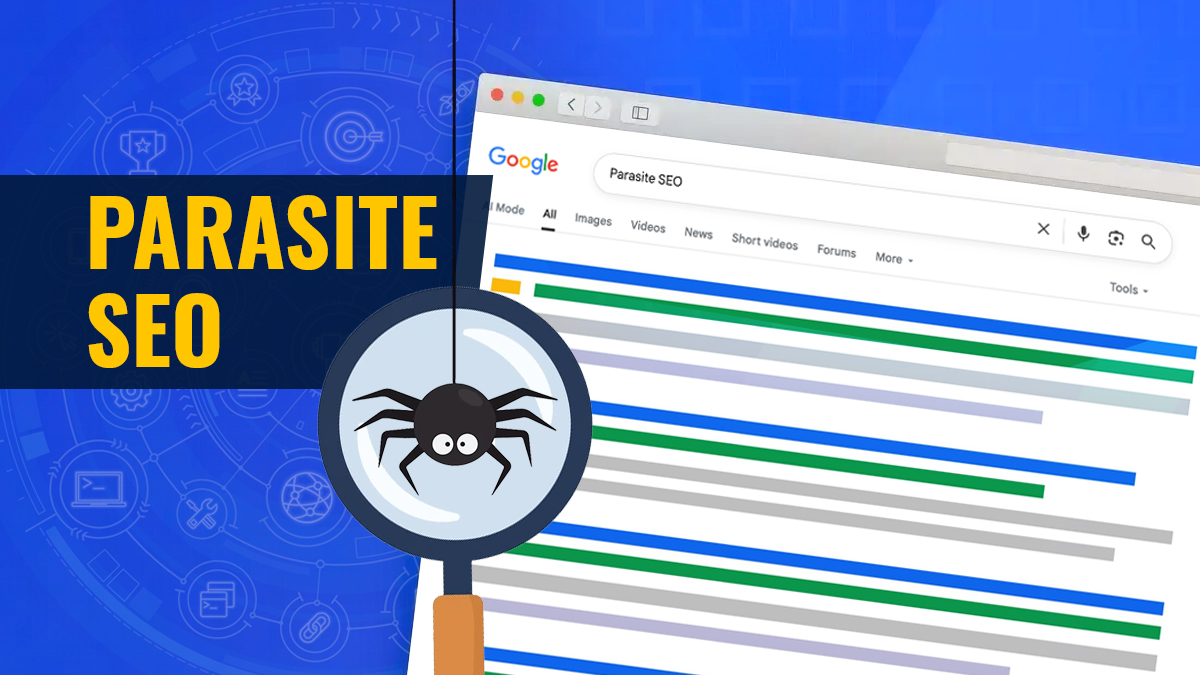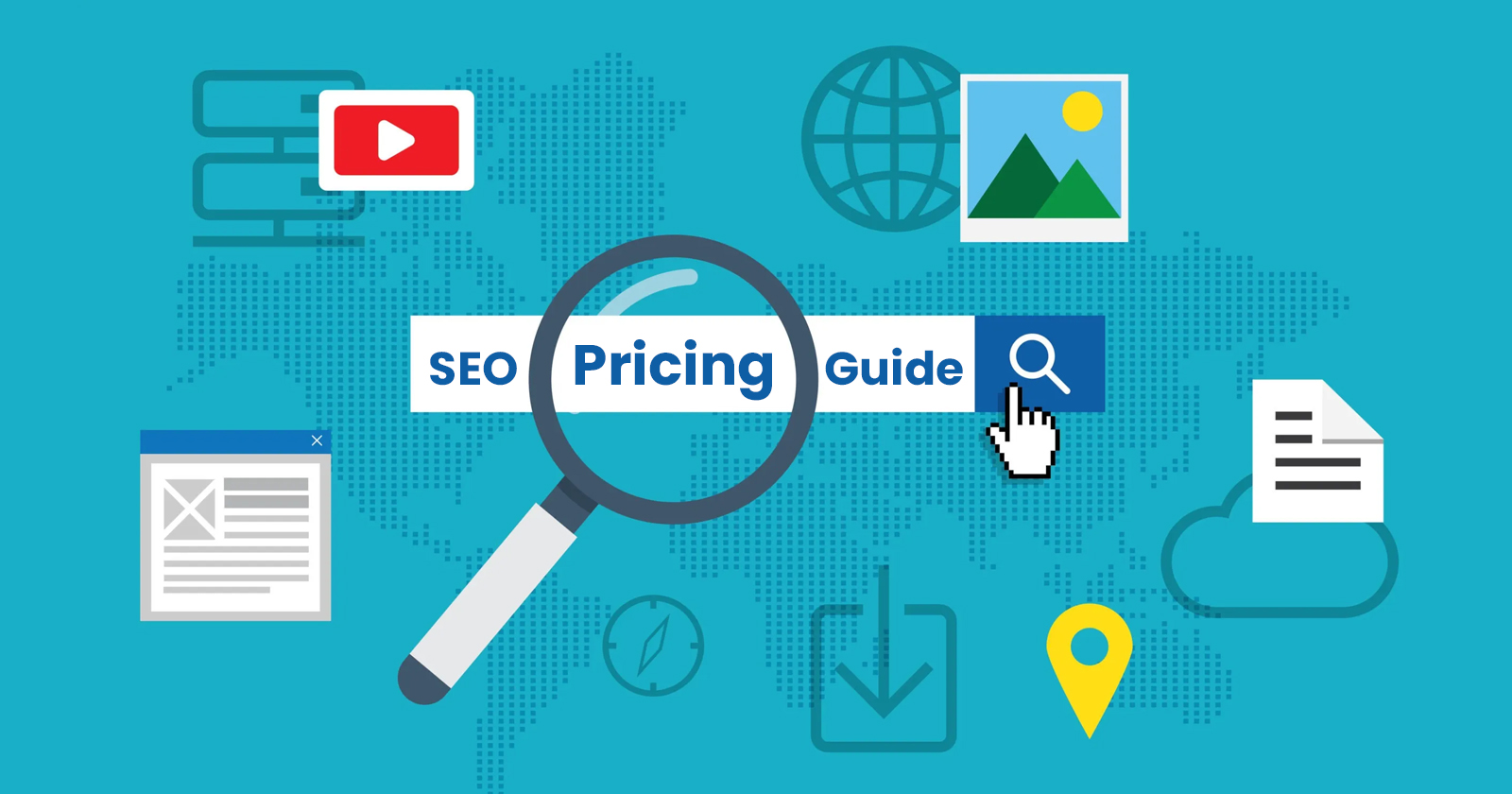Parasite SEO is a method of improving website visibility in search engines by posting content on well-known websites. This helps the content rank higher and faster. Instead of just using their own website for visibility, marketers share their content on popular websites like Medium, LinkedIn, Reddit, or news sites.
These websites are already trusted by search engines, which helps new content show up higher in search results faster and more easily than it would on a new or less trusted site. The word “parasite” means using another website’s trust or credibility to gain advantages, like “riding along” on its search engine success.
Some people see parasite SEO as a risky tactic, but it is becoming more popular with affiliate marketers, and local SEO experts. It provides an easy way for people who don’t have much money or time to improve their site’s ranking. In this post, we will see the steps to do parasite SEO the right way and the benefits if done properly.
What is Parasite SEO?
Parasite SEO means making and improving content on popular websites to help get certain keywords to show up better in search results and bring more visitors to a target website.
Experienced SEO service providers use Parasite SEO ethically by leveraging high-authority platforms to boost visibility while strictly adhering to search engine guidelines and maintaining brand credibility.
This method uses the trust and popularity of these platforms, helping marketers get better rankings faster than with regular SEO methods. The main idea of parasite SEO is to use the popularity of well-known websites to get more attention for your own content.
It means taking advantage of these sites to help your own site get noticed. By posting on websites that have a good reputation, marketers can take advantage of the site’s strong SEO.
By writing articles for well-respected websites, you can get good backlinks and increase your reputation in your field. It’s common for websites to use parasite SEO tricks by creating fake links to their own pages to look more trustworthy.
This means putting links to other pages in places where they don’t really fit, in order to take advantage of those pages’ reputation on the website.
Is Parasite SEO an Unethical Practice?
Parasite SEO isn’t unethical by itself if done properly, but some people use it unfairly to change search rankings. Ethical parasite SEO means making helpful, high-quality content on trusted websites, while following their rules.
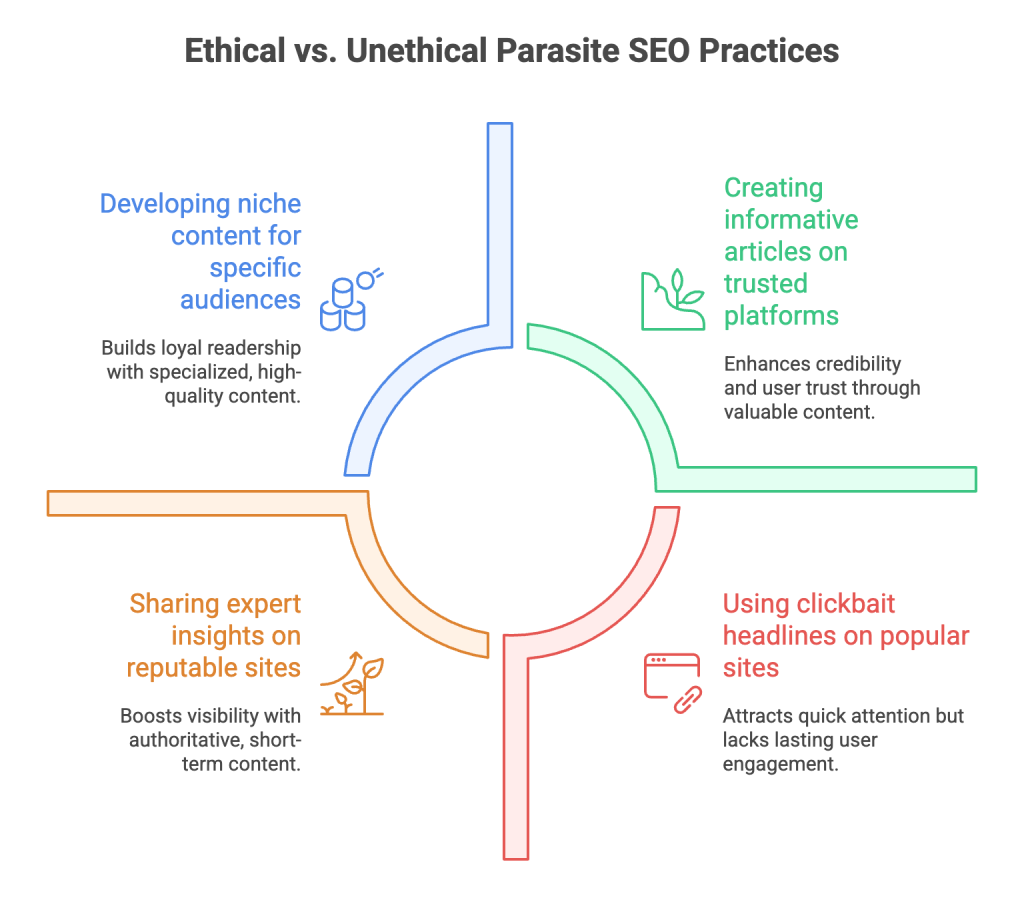
This method can be a good way to make your website more visible and attract more visitors naturally. However, parasite SEO can become dishonest when people use a “churn and burn” method.
This means using well-known websites just to get higher rankings quickly, without thinking about how it affects users or the future. A famous example of this is Forbes. In the last few years, Forbes Marketplace (which is not the same as Forbes) has hired many freelance writers to make content on a wide range of subjects.
Forbes worked with Forbes Marketplace and used their strong online reputation to share many articles that weren’t their usual focus. Why would they do that? Forbes did this for two main reasons:
- They greatly boost their website visitors by ranking for more keywords, which leads to higher advertising earnings.
- Each article has affiliate links that help Forbes make money.
Forbes used an unethical SEO strategy called “Site Reputation Abuse”. This means they took advantage of their strong online reputation to share information that they don’t really know much about.
This mistake can cause incorrect information to show up in search results if it’s not written and checked by experts. In 2024, Google changed its rules to stop unfair SEO practices, like those used by Forbes Marketplace, that try to trick search rankings without giving people useful information.
Parasite SEO can be done in a good way if you share useful, high-quality information that is related to what you know well. In this post, we’ll teach you how to do parasite SEO correctly.
How to Do Parasite SEO the Right Way?
Look for Trusted Platforms
First, look for websites that are very reputable and trusted. Websites like Reddit, LinkedIn, and Medium are great places to begin. Find websites or platforms that match your interests and have people who are likely to interact with what you share.
Websites that usually have a domain rating of 60 or more are usually very trustworthy. So, you should use this number as a goal when you make your list. Look at how good the incoming links to the website are.
Well-known websites usually get links from trusted places, like educational institutions or big news outlets. These links can help your content rank higher in search results. Pick a platform that matches your topic, because the people who already visit that site are likely to be interested in what you share.
Placement on Host Sites
Once you’ve found important websites, you can see if you can be a guest blogger for them. Email lead editors and content managers to tell them about your content ideas. You should share your experience so they can see what you know about their field.
Focus on the way you speak, the type of information you share, and any rules or likes they may have. On Q&A sites, blogs, and social media, you can share your content directly without needing to ask for permission first.
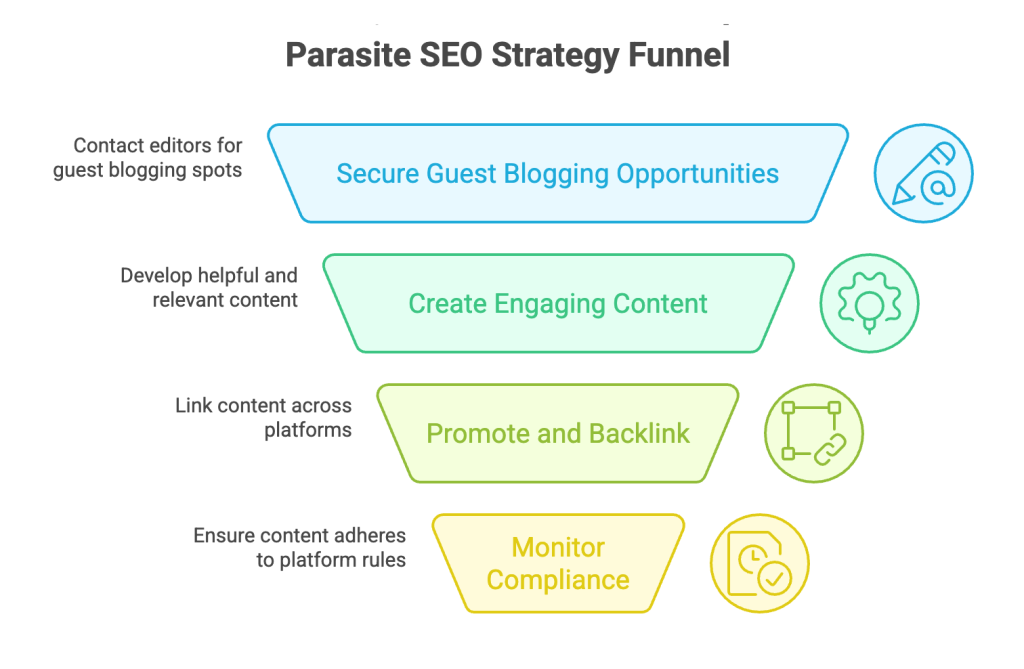
Creating Great Content
Your content should be helpful, interesting, and suitable for the people who use the platform. Try to offer helpful information, whether it’s through good analysis, useful tips, or interesting stories. Quality is important, so take time to research and present your work well.
Even when using the trust of another platform, the basic rules of SEO still matter. Use important words in your writing, create catchy titles, and make sure your meta descriptions are clear. This will make your content easier to find on the platform and in search engines.
Promotion and Backlinking
After adding content on a trusted website, you can start linking to that content from your own blog and link back to your blog from there. When you make a guest post, you can add links to other things you’ve written, like posts on your own blog or articles on other websites.
To organize it, you can make a list of all your guest posts in a spreadsheet. You can list where you’ve added backlinks to make sure your linking plans cover all the content you’ve created on different platforms. Making a spreadsheet will help you find new chances to build links in your content.
Compliance and Monitoring
Every platform has its own rules. Get to know these things so your content can be approved. Note how the tone sounds, what type of content it is, and any specific rules or likes they may have. Use tools to check how well your content is doing.
Numbers like views, shares, and click rates can show us what is good and what needs to be improved. To keep your content following the rules, make sure to check for new updates to algorithms and changes in platform policies.
Also Read: Rank #1 on Google: Secrets of Semantic SEO Revealed!
Parasite SEO Implementation Guide
Identify and Vet High-Authority Host Sites
Begin by finding websites that have good SEO scores, look for a Domain Rating (DR) of 60 or more, lots of organic traffic, and content that matches the topic you’re interested in.
Use tools like Ahrefs to discover reputable websites like Medium (DR 95), Substack (DR 77), and Quora Spaces (DR 91). Find websites that are steadily getting more backlinks, improving their keyword rankings, and have low spam scores.
Make sure the site lets users add their own content or guest articles. Use filters to find pages that can get a lot of visitors but aren’t too hard to rank for. A website with over 10,000 visitors each month and an active audience in your field is perfect.
Stay away from websites filled with a lot of low-quality content, because they can lower your SEO value. Look for indexing problems using Google’s “site:” search. Check your competitors’ backlink profiles to find links that are not helping them.
Make a list and rank it based on who has authority, how well it matches your audience, and how easy it is to help. This step is very important for improving how well you can be seen and ranked over time.
Approach and Pitch Editors
When reaching out to editors, keep your message short, personal, and focused on the benefits. First, find out who is the content editor or manager for contributors. You can use LinkedIn or Hunter.io to help you with this.
Make a pitch that shows how both you and the site can gain from working together. For example, you could say, “I saw that [Site] talks about [Topic], and I have a special, high-quality article on [Relevant Angle] that your readers will love”.
Choose a subject line that grabs attention but still looks professional, like “Great Content for Your [Site Topic] Readers”. Include a short description about the author, examples of past work, and explain how your article can attract more readers or visitors.
Don’t use language that sounds like unwanted advertising. Check back in 3 to 5 days if you don’t hear back. Here’s a simple outreach template:
Subject: Guest Content for [Site Name]
Hello [Editor Name],
I’m [Your Name], and I create content strategies for [Notable Brands].
I would like to write a post for [Site] about [Topic], sharing my [Unique Insight]. I’ve included 2 examples of my previous work and can make changes to fit your audience. Is this a good match?
Regards
[Your Name]
Optimize Content Specifically for the Host Platform’s Audience and SEO
Adjust your content to match the style of the platform, what the audience likes, and how things get ranked. First, look at the best performing content on the website using tools like BuzzSumo or the “Top Pages” feature in Ahrefs.
Find popular types of content, titles, and main keywords to focus on. Use semantic SEO: include related words naturally, focus on keywords with low to medium competition, and improve your H1 to H3 headings.
Add links to trusted sources and your own website pages (like linking to popular Medium articles if you’re posting on Medium). Change your style, Quora likes short answers, but Medium is good for longer stories.
Add clear action prompts, use structured data if you can, and include pictures or videos. Using too many keywords will lead to penalties; instead, concentrate on being knowledgeable about the topic and making your writing easy to read.
Add prompts for sharing on social media to increase sharing. Think about using platform-specific features, like the “clap” button on Medium or the voting system on Reddit, to help people see your content after it’s published.
Track and Measure Results
After your parasite SEO content is published, keep an eye on how well it is doing in terms of visitors, search rankings, and links from other sites. Use Semrush to check how well your keywords are ranking, how many websites link to your page, and how much free traffic your page gets.
Create notifications for new backlinks or mentions. For websites that work with Google Search Console (like your subdomain on Medium), you can check how often your site appears in search results, your CTR, and whether your pages are indexed.
Use UTM tags on links to track visitors with Google Analytics. If you are sharing affiliate links or calls to action, keep an eye on how many people take action using tools like Bit.ly or your own customer management system.
Check how long people stay on the content, how many leave quickly, and how much they interact (like, comment, share). Set goals (like getting over 300 visits in 30 days) and check the content again if the results are not good.
Keep updating and sharing your popular posts to stay high in the rankings. Make a dashboard to bring together important performance metrics and return on investment. Keep tracking your progress over time to improve your plan and figure out which websites and types of content work best for getting more search engine traffic.
Google’s Latest Site Reputation Abuse Policy
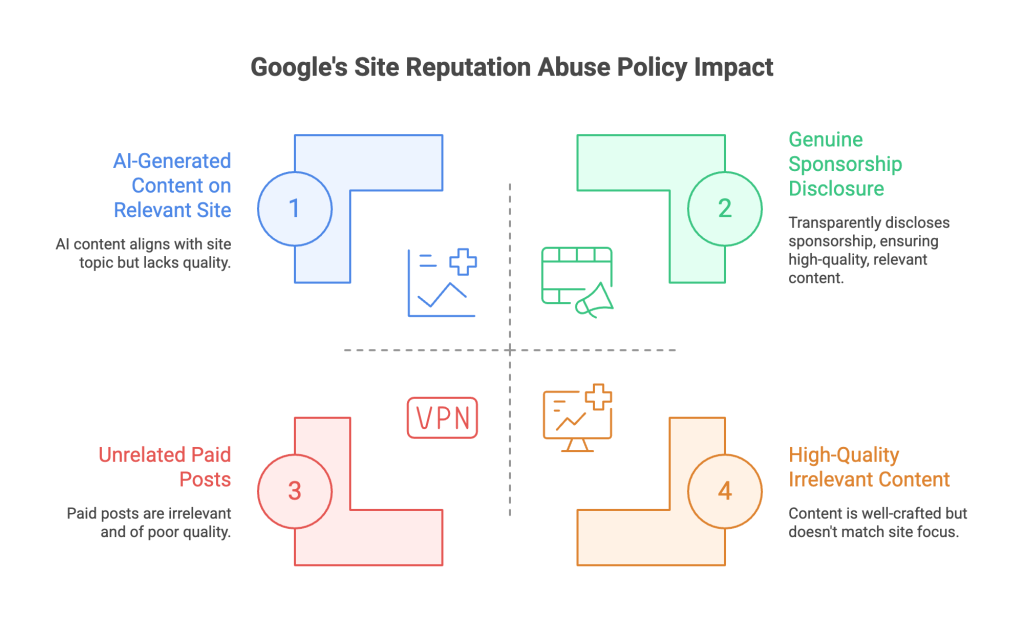
Understanding Site Reputation Abuse Penalties
In its newest update, Google is focusing on “Site Reputation Abuse” to fight against tricky SEO practices on well-respected websites. This policy punishes websites that put low-quality content from other sources just to improve their own rankings.
Common reasons include posting unrelated, promotional, or AI-made articles on trusted websites without proper review. Google now takes action against both the main website and the specific page that broke the rules.
This is meant to stop “parasite SEO” problems, where low-quality content ranks high just because the website is well-known. To avoid fines, make sure that content from other sources matches your site’s main goals, is of good quality, and isn’t misleading.
Hosts should check the rules for contributors and make sure the content meets quality standards. Publishers need to focus on providing real value, connecting with the right audience, and being clear about sponsorships. If your content seems like a quick way to improve rankings or doesn’t help your audience, it might be marked under this rule.
Risky SEO Tactics Under Fire: Content Types Google Now Penalizes
Google’s Site Reputation Abuse policy now identifies many types of content and practices as very risky, especially when they are found on trusted websites. Main problems include paid posts that aren’t checked for quality, articles made by AI, and pages focused too much on affiliate links that don’t offer much helpful information.
For example, adding an article called “Best VPNs of 2025” on a health website like Healthline (which isn’t related to technology) would get a penalty. Other warning signs include coupon pages on websites that don’t match the topic, product reviews that don’t provide real information, and content that is added just to rank better in search results.
Websites that let anyone publish content, like forums or user-generated content platforms, now need to check what people post for relevance and quality. Google wants to see genuine intentions.
If the content is only made to trick search rankings, it probably breaks the rules. To stay safe, don’t use low-quality content, clearly show if something is sponsored, and only publish articles that match the topic and have been reviewed.
White-Hat vs Black-Hat Practices
Relevant Content
- White Hat
White hat SEO focuses on making useful, good-quality, and original content that helps users. The main goal is to match what the user wants, whether they are looking for information, wanting to buy something, or trying to find their way around.
Writers and marketers learn what their audience cares about and what problems they have. They create content that clearly answers these questions and concerns. The content is organized, has correct grammar, and includes pictures, videos, and graphics to make it easier to read.
Keywords are added smoothly to support the story without interrupting the flow. Content is frequently updated with latest data to keep it fresh and correct, which shows crawlers that the site is active and trustworthy.
- Black Hat
Black hat SEO usually creates content that is focused on keywords but isn’t very deep, clear, or helpful. This could mean automatically created articles, badly rewritten content, or catchy headlines that don’t provide what they promise.
The aim is to get good rankings instead of helping the reader. Sometimes, bad SEO practices involve making many similar pages about the same topic to take over search results.
This might get a lot of attention for a short time, but it can also cause many visitors to leave quickly and not interact much. Search engines are punishing websites with low-quality or unrelated content, so using this strategy is risky and won’t work in the long run.
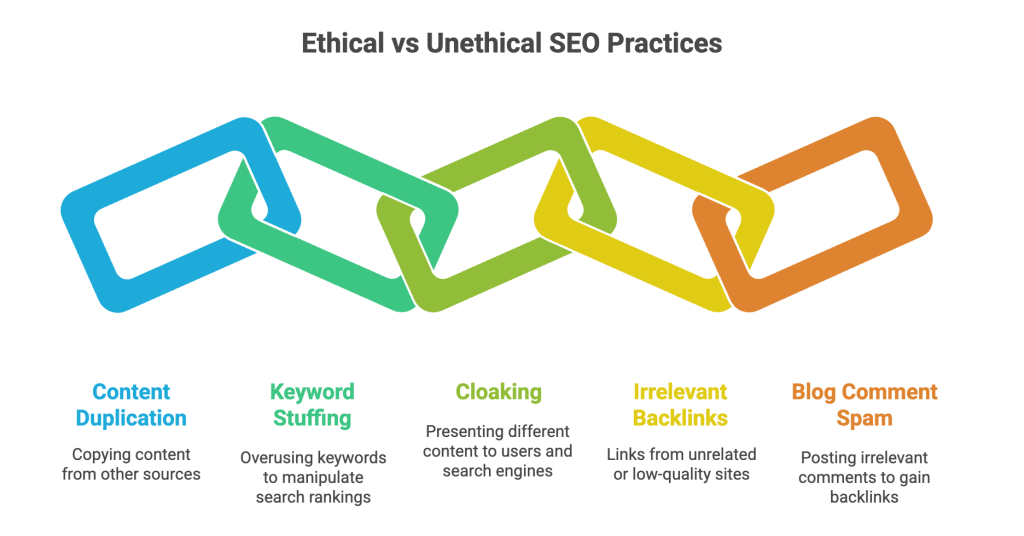
Content Duplication
- White Hat
White hat SEO follows search engine rules by creating original and unique content for every page. When similar content is needed, like in product descriptions for similar items, canonical tags are used to show which version is the main one.
Trusted website owners don’t copy text from other sites. When they mention or refer to someone else’s work, they give proper credit. This method helps to avoid fines and also gains the trust of readers.
Tools like Copyscape help you find unintentional copied content before you publish something. Also, white hat SEO experts spend time doing research, talking to specialists, and writing in a creative way to make sure their content is unique and different from others.
- Black Hat
Black hat SEO often includes copying content from other websites or from the same site (internal duplication) to trick search engines into ranking a site higher. One common way is called “content scraping,” where people take information from successful websites and share it again without asking for permission or giving credit.
Another method is using content spinners to change bits of an article so it looks different and doesn’t get noticed. These tricks make many less important pages to fool search engines into thinking the website has more content than it actually does.
Even though using duplicate content might help improve search rankings for a little while, search engines are good at finding and punishing it. In some cases, they may even remove the offending sites from their search results.
Keyword Stuffing
- White Hat
White hat SEO uses keywords carefully and not too much. Before creating content, you carefully look for keywords that match what users are looking for and that can help improve your rankings.
These keywords are added naturally into the content, such as titles, headings, short descriptions, and image tags. The aim is to help the theme and structure of the content while making sure it is easy to read and helpful.
Semantic variations help make the language sound more natural. You also check how users interact with the content by measuring things like how long they stay on the page, how far they scroll, and if they leave the page quickly.
- Black Hat
Black hat SEO uses too many keywords in content, which can make the text hard to read. This can mean using the same word many times in one paragraph, using unrelated or misleading words to get people to click, or making words the same color as the background so they’re hard to see.
This strategy relies on old methods that used to give more importance to how many times a word was used instead of how good the content is. Putting too many keywords in your content might make it easy to find at first, but it can make the experience worse for users.
It can also lead to penalties, and it can be very difficult to get back your original ranking. Websites that use this method often have few visitors who take action and are often removed from results pages.
Cloaking and Irrelevant Backlinks
- White Hat
White hat SEO focuses on getting good-quality links from trustworthy websites that are in the same field or a similar one. These links are usually gained by creating good content, reaching out to others, writing for other websites, and doing online PR.
Every backlink is positioned where it makes sense and provides real benefit to readers. Being clear and open is important too, good SEO doesn’t use tricks like misleading links and makes sure that both people and bots see the same information.
Google likes these good practices and often gives higher rankings and more trust to sites that use them. Having more backlinks does not matter if the links are not from a relevant niche site.
- Black Hat
Black hat SEO uses dishonest tricks like buying links, joining groups that exchange links, or making networks of secret blogs to quickly increase a website’s reputation. These links usually come from websites that aren’t good and don’t relate much to what they’re linking to.
Another common bad practice is cloaking, where people and search engines see different content. For example, a page may seem like it’s a site for product reviews, but it really sends users to a spammy or unrelated website.
These tricks are serious violations of Google’s rules and can lead to penalties, lower rankings, or getting the site removed from search results completely. Your site must offer the same content for both crawlers and users.
Blog Comment Spam
- White Hat
White hat users might join conversations in blog comments, but they always want to add something useful to the discussion. They read the article, share their ideas or questions, and only add a link if it really helps the discussion.
Links are usually included in the comment or the user’s profile, and they are not pushed too hard. This method helps create connections, establish trust, and drive free traffic through recommendations.
It’s also a way to connect with others in a specific field without getting in trouble with search engine rules. You can get new ideas from the comments section of articles as you get to know the viewpoints of many people.
- Black Hat
Black hat SEO uses spam comments in blog sections to promote low-quality or unrelated websites. This can be done automatically or manually. These comments usually have general compliments like “Great post” and include a link full of keywords.
These comments might not relate to the topic at all. Spambots are often used to send these comments to many blogs to try to get links back to their site. Most modern content management systems use spam filters like Akismet to block these attempts.
Even if a spam comment gets posted, search engines usually ignore those links or punish the website being promoted. It lowers the quality of the website and people’s trust, and it doesn’t help improve rankings in the long run.
Also Read: What Is A Backlink Profile in Google’s Eyes?
Top Emerging Parasite SEO Platforms for 2025
High-Authority News Sites Open to Contributors
Popular news websites like Entrepreneur.com, Forbes Councils, Thrive Global, and Business 2 Community provide great chances for improving SEO if used the right way. These websites usually have high ratings between 80 and 95 and get millions of visitors every month, making them great for content that needs to rank quickly.
Many of these platforms require payment or invitations to join, but they offer a trusted place for high-quality content, expert opinions, and brand mentions. Submissions should be well-written, original, and suitable for the site’s readers.
Skip hype and instead share useful information based on facts or your experience. Usually, you have to apply or be accepted into a contributor program, which can be through platforms like ClearVoice or by working with agencies.
Publishing here takes more work and might cost more, but the benefits for SEO, like getting trusted links, quick indexing, and ongoing visibility, make it a good choice for content marketers who want lasting results.
Industry Forums and Q&A Sites
Niche forums and Q&A sites are becoming more useful for parasite SEO, especially when focusing on specific phrases or questions. Websites like Stack Exchange (for developers), Patient.info (for healthcare), Avvo (for legal advice), and GitHub Discussions have strong credibility and attract many active users.
Most of these sites don’t allow obvious ads, but they do give rewards for detailed, well-researched answers that help improve conversations. This makes them perfect for indirect SEO strategies, which involve placing links in helpful content that people find useful and want to click on.
These websites usually appear at the top of search results because they are trusted and have well-organized information. Creating a trustworthy profile over time (by getting upvotes, badges, or points) makes you more visible and builds trust, which increases the value of your link.
But getting success here relies on being consistent and genuine. To prevent being flagged or taken down, always share your connections when needed and aim to really help users instead of just trying to get more visitors.
Expired Domains and Marketplace Platforms
Old or expired websites are becoming a strong, though unusual, method in parasite SEO. Websites like Odys Global, Flippa, and Motion Invest sell old website names that have good links from other sites.
These websites usually focus on specific topics like money, technology, health, or education. These websites might have a DR between 40 and 70 and have built up trust over many years. This makes them great for helping new content rank quickly.
To succeed, you need to check the website carefully. Look at its backlink history using Ahrefs, review old content on the Wayback Machine, and watch for any past penalties or spam.
Once you have the domain, you can use it as a specific blog, lead magnet, or a main page with good ranking. Even though the initial costs are higher, this way gives you complete control over how you publish and manage links, letting you build your own strong platform.
Advanced Parasite SEO Strategies
Building Backlinks to Your Parasite Pages for Maximum SEO Impact
Parasite pages get a boost from the reputation of their main sites, but getting more backlinks to them can help them rank much higher, especially in tough markets. First, find blogs, forums, and directories where you can easily add links to your content.
Use guest articles, small updates, or swapping links to boost outside credibility. Use good private blog networks wisely, making sure they look natural and fit well with the content.
Social signals and embeds on sites like Pinterest, YouTube descriptions, or LinkedIn posts can improve search results and increase visibility. Use tools like Ahrefs to check backlink profiles and see how rankings are getting better.
Focus on getting high-quality links rather than a lot of low-quality ones; one link from a strong website can be more effective than many links from weaker sites. Also, use a step-by-step link-building approach.
Link to your parasite page from your own website or blog, and then get other websites to link to that page too. This method improves link value and helps to boost rankings over time.
Using AI Tools for Smarter Content Creation and Keyword Research
AI tools can make the whole process of parasite SEO easier, from coming up with ideas to putting them into action. Tools like ChatGPT, and Copy.ai can assist in creating easy-to-read content that is good for crawlers and suited for websites like Quora.
Use them to plan posts, make different versions, and change the style or length depending on what the host site likes. For finding keywords, tools like Surfer SEO, Frase, and LowFruits.ai can help you discover less competitive, valuable long-tail keywords that are great for parasite pages.
You can use ChatGPT along with data from Moz to find similar keywords and create strong content on specific topics. AI-generated content briefs help you cover all important points, increasing your chances of getting a good ranking.
Make sure to check if AI-created content is accurate and add a personal touch to it so it is not low quality. Using AI effectively helps you grow SEO campaigns about parasites while keeping the quality of content high on different platforms and topics.
Diversifying Anchor Text and Avoiding SEO Footprints
Using different types of anchor text is very important for good SEO, especially when you’re creating a lot of backlinks. Using the same exact links too much can look unnatural and may get you penalized by search engines.
So, use different types of links, like branded, similar name, general, and longer phrases, to make your backlinks look natural. For instance, instead of always using the phrase “best CRM software,” mix it up with phrases like “learn more,” “top-rated platforms,” or “CRM tools reviewed here”.
Also, don’t get all your links from the same types of websites, use the same authors, or create the same kind of content on similar pages. These leave clear signs that Google can follow. Use different publishing platforms, mix up the types of content you create, and make sure each piece offers something special.
Tools like SEO SpyGlass or Ahrefs can help check your website’s links and show you which link texts are used too much. Plan like a good strategist but work quickly like a sneaky one, staying hidden is important for sustainability.
Parasite SEO vs Guest Posting vs Traditional Link Building
| Feature | Parasite SEO | Guest Posting | Traditional Link Building |
| Risk Level | Medium to high risk (controlled by the platform, can be risky if there’s a lot of spam) | Low to medium (depends on the quality of the content and how well it matches the topic) | Low to high risk (safe if using legitimate methods, risky with paid or private blog network links) |
| Speed to Rank | Fast (uses trusted websites to get indexed quickly) | Average (it depends on how trusted the website is and how quickly it gets indexed) | Slow (link value takes time to grow) |
| Price | Low to medium cost (free on user-generated content sites or reasonable fees on paid websites) | Medium to high (usually needs payment for getting listed and for content) | High (doing outreach manually, negotiations, and good content) |
| Long-Term Value | Medium (the owner controls the content; it can be taken down or not shown in searches) | High (often always green; strengthens brand trust) | High (improves your website; strong links) |
| Control | Low (limited editing, content can be taken away by the platform) | Medium (some freedom to edit, but it’s hosted on another site) | High (complete control over what content is shown and where it is placed on your own website) |
| When to Use | For easy results, trying out keywords, or getting ranked without a website | For building a brand, focusing on a specific audience, and gaining lasting trust | To build up domain authority and create long-lasting SEO assets |
Advantages of Parasite SEO
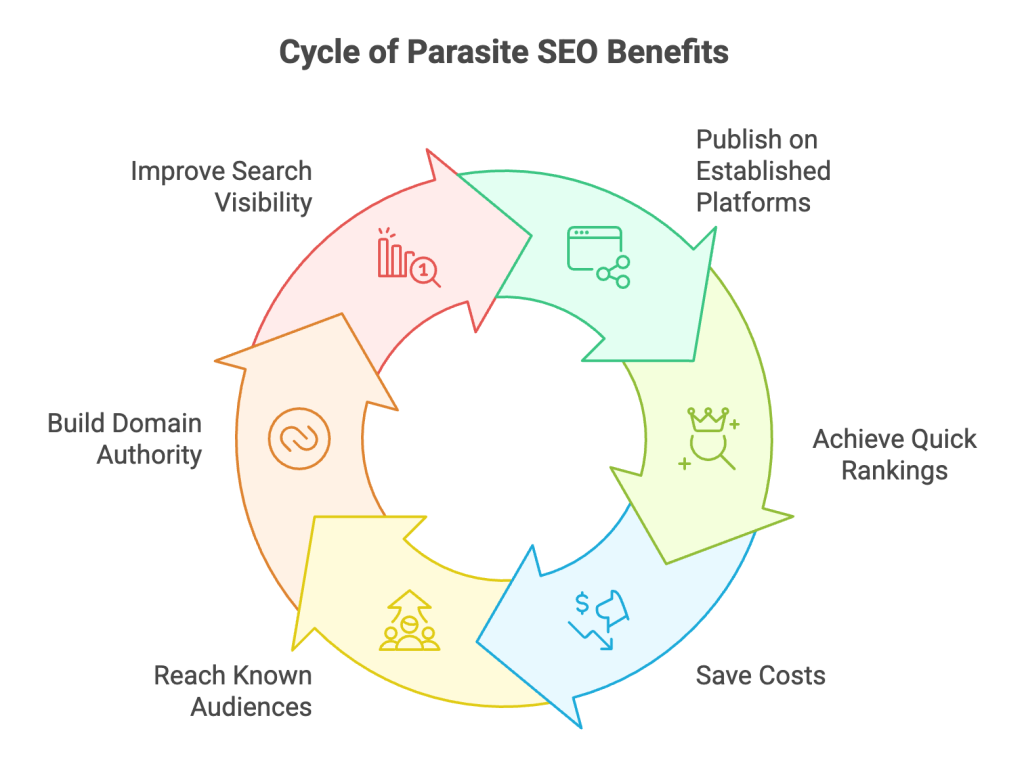
Quicker Ranking Results
Parasite SEO helps marketers get higher rankings quickly by using the popularity of well-known websites. Instead of building a new website from the beginning, SEO experts share their content on well-known platforms like Medium, LinkedIn, or popular news websites.
These websites are already recognized and trusted by search engines, so content posted there can show up in search results quickly. This is really helpful for going after popular keywords that a new website might find hard to compete with.
Because search engines favor stronger websites, content on weaker sites can sometimes show up higher in search results than content on independent sites, even if the quality is the same. It’s a quicker way to gain trust in a website without having to wait a long time.
This is why Parasite SEO is loved by affiliate marketers, product launchers, and people who want fast visibility. But the results might not last long unless you do more SEO work or get more backlinks.
Saves Money
Parasite SEO is much cheaper than regular SEO campaigns. Creating and getting a new website to show up on search engines takes money and effort. You need to pay for a domain name, hosting, set up the site, make content, get links from other sites, and keep improving it.
All of this can cost a lot and take a lot of time. On the other hand, Parasite SEO uses popular websites that already have good reputation, so you don’t have to spend money on making or promoting your own website at first.
Many of these platforms are free to use or only charge a small fee to publish. This means that people or companies with small budgets can still get noticed online without needing an expensive SEO plan.
Also, since content from parasites gets ranked quicker, you can start seeing results sooner. This is really helpful for affiliate marketing, promotions with a deadline, or trying out content strategies before expanding them.
Reaching Known Audiences
One of the perks of parasite SEO is targeting the existing audience of well-known websites. Websites like Medium, Quora, Reddit, and big news sites get millions of people visiting every day.
When you publish on these platforms, more people will see your content. This happens not just because of search engines, but also because of the site’s own tools, like trending lists, topic feeds, or suggested posts.
This can help get more people to visit and interact with you without having to create your own audience from the beginning. Also, people are more likely to trust content on popular websites, which can result in more clicks and sales.
For marketers, this means more people will see their brand, remember it, and possibly make more money from it. Using Parasite SEO to reach these groups helps build trust quickly and brings in visitors who are already interested in certain subjects.
Higher Domain Authority
Parasite SEO doesn’t boost your own site’s authority directly, but it can help indirectly by building links in a smart way. By adding links in content hosted by parasites, you can create strong links that lead to your website.
These backlinks come from trusted websites that search engines see as reliable sources. Over time, this can make people trust your website more and see it as a reliable source, which will help your pages rank higher in the future.
Also, if the parasite page does well and shows up high in results pages, it can help bring visitors to your main site, improving your overall SEO. For businesses creating an online presence, this strategy helps improve their domain reputation.
It’s very useful when combined with guest posts, mentions from influencers, and editorials. Using parasite SEO and specific backlink strategies together gives you two advantages: quick visibility and lasting authority for your main website.
Better Visibility in Search Engines
Parasite SEO helps you get noticed in search results by putting your content on popular websites. These websites usually have good ratings, high trust flow, and lots of backlinks, which helps their content show up at the top of search results.
When your content is on these websites, it gets some of their strength in SEO, which makes it more likely to show up on the first page of Google for popular search terms. This visibility helps you reach more people quickly and without the cost and time of building your own website’s reputation.
It lets you show up in search results many times if you post similar content on different websites, making it harder for your competitors to be seen. This method is really helpful for managing your reputation, affiliate marketing, and local search engine optimization.
It makes sure your message stands out in results pages, helping you stay ahead of the competition, even if your website isn’t fully developed yet. Once you get good visibility, the visitors might proceed to directly check out your site.
Dangers of Using Parasite SEO
Parasite SEO can be very helpful, but it’s important to use good methods by making useful content that follows search engine rules and the host site’s policies. Don’t use shady methods like spammy links or poor-quality rewritten content, as these can result in penalties or being removed from search engines.
Posting on sites with spammy or unrelated content can hurt your brand’s trust. People might think your content is not very good because of the site it’s on. Using black hat methods can damage the trust of both users and search engines.
This makes it hard to restore your reputation and search rankings over time. Google works to stop bad SEO practices by using rules like the “Site Reputation Abuse” update. This update punishes websites that unfairly use other sites to improve their own ranking.
This can make your content rank lower or get removed from search results. If the hosting platform is marked for having a bad reputation, both the platform and your content can get in trouble.
Forbes was punished by this update, causing many of their pages to be taken out of search results. Their team reacted by officially ending their relationship with the freelancers. Once you post your content on another website, you can’t control it anymore.
The website where your content is hosted can change, reformat, or remove it at any time without telling you. This could harm your brand or affect your ranking on search engines. It is advisable to regularly monitor the content you have on third-party websites.
Risks, Downsides, and Reputation Management
Reputation Bleed in Parasite SEO
Reputation bleed happens when poor-quality or highly promotional content on a trusted website harms the trustworthiness of both the brand being advertised and the website itself.
In parasite SEO, marketers take advantage of trustworthy websites to post low-quality, unrelated, or misleading content just to improve their search rankings. If the content looks off, too focused on selling, or confusing, people might think poorly of the brand it comes from, even if it performs well.
If a website gets filled with low-quality or misleading content, people may start to see it as less reliable, which could lead Google to take action against it. This hurts everyone involved: the host gets less visitors and trust, and the brand might face negative sentiment, less trust, or backlash on social media.
Using parasite SEO for quick benefits can lead to serious problems over time, both for your reputation and with algorithms. Using resources wisely means making sure the content matches what the audience wants and follows the rules for good writing.
Tips for Monitoring and Protecting Your Brand
- Regular SEO and Content Audits
Regularly auditing your website is important to keep your brand safe from bad SEO practices. Use tools like Screaming Frog to keep an eye on all published content, check where the links are coming from, and find any low-quality or spammy links.
Check each live page to make sure the information is correct, relevant, and follows the editorial guidelines. Mark any old, inaccurate, or overly stuffed content with keywords for updating or removal.
Look for updates in the site’s authority or indexing status that could impact performance. Audits should check how different the anchor texts are and how healthy the links are. Doing a regular monthly check helps keep your strategy clear, effective, and up-to-date with Google’s changing quality rules.
- Setting Up Brand Alerts and Monitoring Mentions
Use tools like Mention, or Brand24 to see where people are talking about your brand online, including any unwanted SEO mentions. Set up notifications for your brand name, products, and important people to see both good and bad mentions as they happen.
These tools help you keep track of surprise backlinks, unwanted content, or possible public relations problems from other websites. Also, keep an eye on your brand’s social media to see what people are saying about harmful content.
When you get alerts about bad or misleading content, take action right away: reach out to the platform or ask for changes to protect your brand and keep your audience’s trust. Keep an eye on different ways people spell your brand name to find mentions that you might overlook.
Look at how people’s sentiments change over time to spot possible problems early. Regularly checking your brand’s online presence helps keep things consistent, boosts your reputation, and allows you to deal with problems or changes quickly.
- Vetting Hosts and Enforcing Quality Standards
Check the website carefully before posting anything on it. Use Moz to see how strong a website is, how good its visitors are, and what links it has from other sites. Make sure the platform is listed, working well, and respected in its area.
Stay away from websites filled with spammy or AI-made content, as they can lower how people view your brand’s value. Make rules for the quality of content shared outside, including how it sounds, checks for accuracy, and matches the brand’s voice.
Keep a list of safe websites and a list of websites that are not safe. By carefully picking trusted hosts and maintaining good quality, you lower the chance of harming your brand and reputation.
Parasite SEO in YMYL Niches
Parasite SEO is very risky in YMYL (Your Money or Your Life) areas, which include topics like finance, healthcare, and legal advice. This is because Google expects these topics to have the best quality and trustworthiness.
In these areas, wrong information can seriously affect someone’s finances, health, or safety, so Google is more careful with its search results. Even if the website you use is trustworthy, linking your brand to low-quality or rule-breaking content in important topics can cause problems.
Publishing poor-quality or basic content created by AI on well-respected websites might help you rank higher for a short time, but it can quickly lead to being removed from search results, harm to your reputation, or even penalties from search engines.
To work safely in important areas like health or finance, all SEO content should be correct, thoroughly checked, and ideally written or reviewed by real experts who have the right skills and qualifications.
Use reliable sources, don’t make big or unrealistic statements, and clearly share any affiliations you have. Keep in mind that in important niches, Google cares more about user safety and trust than about smart SEO tricks.
Brands in these niches should see parasite SEO as a way to boost their brand, not as a sneaky trick to get quick rankings. They should make sure all external content meets high quality standards to prevent serious legal and algorithm problems.
Final Thoughts
In a world where online competition is tough, parasite SEO offers an easy way to get noticed, especially for people who find it hard to make their own websites rank higher. By using the strong reputation of popular websites, content creators can avoid the time and effort needed for regular SEO work.
The advantages, like getting better rankings quickly, saving money, reaching more people, and being seen more on search engines, make it a good choice for marketers and small businesses. It’s important to use parasite SEO carefully and responsibly.
Relying too much on outside websites or using black hat methods can result in less success or even getting your content taken down. Ideally, parasite SEO should support your long-term SEO strategy.
It acts as a way to help you gain recognition while you work on strengthening your own site. When done right, it gives quick visibility and chances to build a lasting online presence. Like any plan, it works well when it’s done well, done regularly, and done carefully.
FAQs
How does parasite SEO improve search engine rankings?
Parasite SEO uses the strong reputation and links of a trusted website to improve the visibility of another site. These sites have good connections with search engines, so new content they post can rank quickly without waiting. Sometimes, pages made with parasite SEO can get to the top of search engine results very quickly, even within a few hours. This is very helpful for important keywords, new product launches, or promotions that need fast attention.
Is parasite SEO seen as a bad practice?
Parasite SEO is a bit confusing, it isn’t always bad, but it can be if done in the wrong way. If you share helpful content on trusted sites and follow their guidelines, it’s usually considered a good approach. But if you’re filling these sites with poor quality, copied, or overly stuffed content just to trick search engines, it’s considered dishonest. Using parasite SEO ethically means making original content, providing real benefits, and being honest.
How is parasite SEO different from guest blogging?
Both parasite SEO and guest blogging mean sharing content on other websites, but they have different aims and ways of doing it. Guest blogging usually happens through official partnerships or by reaching out to others. The goal is to get links and more visibility on websites that are related to a specific topic. Parasite SEO means using public websites where you can post your content easily, usually without asking for permission. The goal is to get visibility immediately, rather than to build relationships.
Is there a chance that content could be taken down?
Yes, there is always a chance of something going wrong when using websites or apps that you don’t control. If your content breaks the rules of a platform, like being too pushy, misleading, or spammy, moderators might take it down. Even good content can be removed or marked because of new rules or incorrect complaints. To reduce this risk, always follow the rules of the platform, don’t promote yourself too much, and provide real value to your readers.
Does Google punish websites that perform parasite SEO?
Google doesn’t punish the use of parasite SEO itself, but it does punish poor-quality content, tricky linking methods, and breaking webmaster rules, no matter which platform you use. If your content about parasites is full of spam, wrong information, or too many unnatural links, it could lead to your content being removed from search results. But if done right, by using helpful, clear, and related content, parasite SEO can be a real method to get short-term benefits in search engine rankings.
